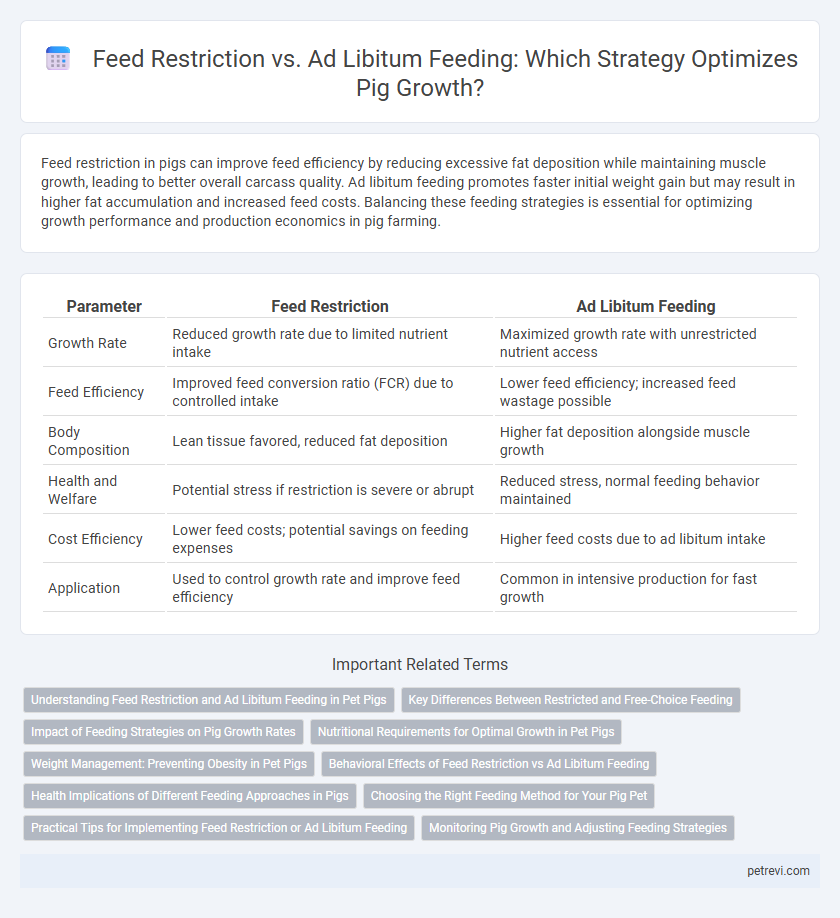Feed restriction in pigs can improve feed efficiency by reducing excessive fat deposition while maintaining muscle growth, leading to better overall carcass quality. Ad libitum feeding promotes faster initial weight gain but may result in higher fat accumulation and increased feed costs. Balancing these feeding strategies is essential for optimizing growth performance and production economics in pig farming.
Table of Comparison
| Parameter | Feed Restriction | Ad Libitum Feeding |
|---|---|---|
| Growth Rate | Reduced growth rate due to limited nutrient intake | Maximized growth rate with unrestricted nutrient access |
| Feed Efficiency | Improved feed conversion ratio (FCR) due to controlled intake | Lower feed efficiency; increased feed wastage possible |
| Body Composition | Lean tissue favored, reduced fat deposition | Higher fat deposition alongside muscle growth |
| Health and Welfare | Potential stress if restriction is severe or abrupt | Reduced stress, normal feeding behavior maintained |
| Cost Efficiency | Lower feed costs; potential savings on feeding expenses | Higher feed costs due to ad libitum intake |
| Application | Used to control growth rate and improve feed efficiency | Common in intensive production for fast growth |
Understanding Feed Restriction and Ad Libitum Feeding in Pet Pigs
Feed restriction in pet pigs involves controlled, limited feeding schedules to manage weight and prevent obesity, enhancing overall health and longevity. Ad libitum feeding allows pigs unlimited access to food, promoting rapid growth but increasing risk of excessive fat accumulation and metabolic issues. Understanding these feeding strategies helps optimize pig growth while balancing nutritional needs and preventing health complications.
Key Differences Between Restricted and Free-Choice Feeding
Feed restriction in pigs limits daily intake to control growth rate and improve feed efficiency, often used to minimize fat deposition and enhance lean muscle development. Ad libitum feeding allows pigs unrestricted access to feed, promoting faster growth but potentially increasing fat accumulation and feed costs. Key differences include feed intake control, growth rate modulation, and carcass composition outcomes.
Impact of Feeding Strategies on Pig Growth Rates
Feed restriction in pigs typically slows growth rates by limiting nutrient intake essential for muscle development, whereas ad libitum feeding maximizes growth by allowing unrestricted access to feed, promoting higher daily weight gain. Studies indicate that pigs on ad libitum diets achieve faster growth rates due to increased energy consumption supporting accelerated muscle accretion and overall body mass. However, feed restriction may improve feed efficiency by reducing fat deposition, influencing carcass quality while moderating growth velocity.
Nutritional Requirements for Optimal Growth in Pet Pigs
Feed restriction in pet pigs can help control body composition and prevent obesity while meeting essential nutritional requirements such as balanced protein, energy, and fiber intake. Ad libitum feeding provides continuous access to nutrients but risks overconsumption, leading to excessive fat deposition and metabolic disorders. Optimizing nutrient density and feeding strategies ensures pet pigs achieve steady growth rates, maintaining health and longevity.
Weight Management: Preventing Obesity in Pet Pigs
Feed restriction in pet pigs effectively manages weight by limiting caloric intake, thereby preventing obesity and related health complications. Ad libitum feeding, while promoting faster growth, often leads to excessive weight gain and increased risk of metabolic disorders. Controlled feeding regimens optimize growth performance and maintain healthy body condition scores in pet pigs.
Behavioral Effects of Feed Restriction vs Ad Libitum Feeding
Feed restriction in pigs often leads to increased activity, oral manipulation, and aggression due to hunger and frustration, whereas ad libitum feeding promotes natural feeding behaviors and reduces stress-related actions. Restricted feeding schedules can cause stereotypic behaviors such as belly-nosing and bar-biting, indicating compromised welfare. In contrast, ad libitum-fed pigs display more exploratory and social behaviors, positively influencing overall growth performance and wellbeing.
Health Implications of Different Feeding Approaches in Pigs
Feed restriction in pigs can improve gut health by reducing the risk of digestive disorders such as diarrhea and promoting a more stable microbiota composition. In contrast, ad libitum feeding often leads to rapid growth but increases the risk of metabolic issues like obesity, insulin resistance, and cardiovascular stress. Optimizing feeding strategies balances growth performance with health outcomes, reducing mortality rates and enhancing overall pig welfare.
Choosing the Right Feeding Method for Your Pig Pet
Feed restriction in pigs can improve feed efficiency and reduce excessive fat deposition, optimizing lean growth and lowering feed costs. Ad libitum feeding promotes rapid weight gain and supports the pig's natural feeding behavior but may lead to increased fat accumulation and higher feed consumption. Selecting the appropriate feeding method depends on the pig's growth stage, health status, and the owner's goals for weight gain versus body composition.
Practical Tips for Implementing Feed Restriction or Ad Libitum Feeding
Feed restriction in pigs can improve feed efficiency and reduce fat deposition by controlling nutrient intake, making it essential to monitor body weight and adjust rations accordingly for optimal growth performance. Ad libitum feeding maximizes growth rates and simplifies management but requires careful monitoring to prevent excessive fat accumulation and health issues such as digestive disturbances. Practical tips include gradual adaptation to feeding regimes, consistent feed quality, and using automated feeders to regulate intake and minimize feed wastage.
Monitoring Pig Growth and Adjusting Feeding Strategies
Monitoring pig growth under feed restriction versus ad libitum feeding involves regular weighing and assessing body condition to optimize nutrient intake. Adjusting feeding strategies based on growth rates helps improve feed efficiency and prevents under- or overfeeding, ensuring optimal muscle development and weight gain. Data-driven decisions incorporating growth performance metrics allow producers to tailor feed allocation for maximizing productivity and cost-effectiveness.
Feed restriction vs Ad libitum feeding for Pig growth Infographic

 petrevi.com
petrevi.com